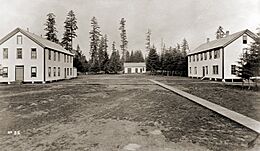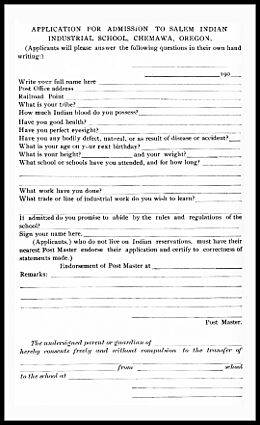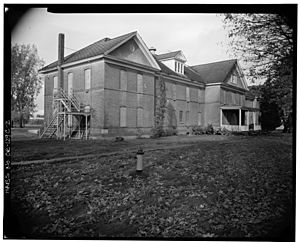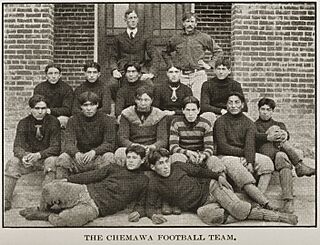Chemawa Indian School facts for kids
Quick facts for kids Chemawa Indian School |
|
|---|---|
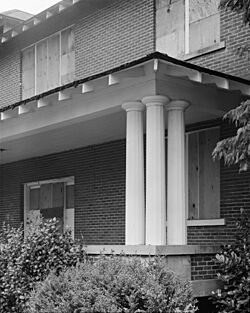
Hawley Hall porch
|
|
| Address | |
|
3700 Chemawa Road NE
, , 97305
|
|
| Coordinates | 45°00′00″N 122°59′05″W / 45.00004°N 122.984712°W |
| Information | |
| Type | Public |
| Opened | 1880 |
| Authority | Bureau of Indian Affairs |
| Superintendent | Don Tomlin |
| Principal | Amanda Ward |
| Grades | 9-12 |
| Number of students | 425 |
| Color(s) | Red, white, and black |
| Athletics conference | OSAA PacWest Conference 3A-3 |
| Mascot | Brave |
| Rival | Willamette Valley Christian School |
| Accreditation | NAAS |
| Website | https://chemawa.bie.edu/ |
|
Chemawa Indian School Site
|
|
| Area | 86 acres (35 ha) |
| Built | 1885 |
| Architectural style | Colonial Revival, Bungalow/Craftsman, Georgian Revival |
| NRHP reference No. | 92001333 |
| Added to NRHP | December 16, 1992 |
Chemawa Indian School (pronounced "Chih-MAY-way") is a Native American boarding school in Salem, Oregon, United States. It is named after the Chemawa band of the Kalapuya people. The school first opened on February 25, 1880, as an elementary school.
Over time, more grades were added. By 1927, Chemawa became a full high school. It is the oldest Native American boarding school that has been open continuously in the United States. Thousands of students have graduated from Chemawa. In 1926, it had its highest number of students, with 1,000 attending.
New buildings were built in the 1970s on a campus next to the original one. The old campus once had 70 buildings, including barns for farming programs. In the 2023–24 school year, Chemawa continued to teach students from ninth to twelfth grades. It mainly serves students from tribes in the Pacific Northwest and Alaska.
The school has had other names in the past. These include Forest Grove Indian Industrial Training School and Salem Indian Industrial Training School.
Contents
School History
How Chemawa Indian School Started
Chemawa Indian School began in the 1870s. At that time, the American government wanted to end conflicts with Native American groups. They hoped to do this by helping Native Americans fit into modern society. This idea was called cultural assimilation.
A military officer named Richard Henry Pratt believed in this approach. He thought that immersive education could help Native American children learn new ways of life. Schools like Chemawa were built far from Indian reservations. This was done to separate students from their traditional cultures.
The first school site was in Forest Grove, Oregon. It cost $5,000 to set up. US Army Lieutenant Melville Wilkinson led the project. He started building the first campus in 1880 with the help of eight Puyallup Indian youths.
The first class had 14 boys and 4 girls. Most were from the Puyallup nation. Boys learned skills like painting, baking, and carpentry. Girls were taught "domestic arts," which meant household skills. Over five years, 382 students from more than 40 tribal groups attended the Forest Grove school.
Moving to a New Location
The Forest Grove site had problems, like poor drainage. Also, there wasn't enough land for farming education. After a fire destroyed the girls' dormitory in 1884, officials looked for a new location. They chose a 171-acre site north of Salem. This site was good because it was close to the state government and had plenty of land.
Construction at the Salem site began in 1885. Temporary wooden buildings were later replaced with stronger brick ones. On June 1, 1885, the Chemawa Indian School opened at its new location. About half the students moved there first. The rest moved later that year.
The first students to graduate finished the sixth grade in 1886. The school then added classes up to the tenth grade. With more land, the school focused on agricultural training. This included dairy farming, animal husbandry, and growing crops. The food grown helped feed the students.
The School's Goals
In 1902, the Commissioner of Indian Affairs, William A. Jones, sent a letter about the school's goals. It said that "sound and healthy" children with enough Native American heritage should enroll. They were expected to stay for at least three years, or even four or five.
The school kept control over the children during this time. Students were not usually allowed to go home for vacations. The goal was to teach them to live like white Americans. Children who were mostly white and lived off reservations were not allowed to enroll.
A Time of Growth
The school grew a lot over the years. The Superintendent's house was built in 1885. Wooden buildings were slowly replaced by larger, permanent brick structures. This happened as the government approved more funding.
The school's hospital was built in 1890. It was a central wooden building with porches. A second story was added in 1900. Chemawa's main school building was finished in 1899. This brick building had 10 classrooms and a large assembly hall.
A big brick building for industrial trades was built in 1902. It had sections for tailors, dressmakers, and carpenters. There were also shops for blacksmithing, baking, and printing. The school also taught farming, gardening, and dairy work.
The school had 30 acres of fruit orchards. These included prunes, apples, cherries, and pears. There were also many small fruits like blackberries and strawberries. McBride Hall, a permanent girls' dormitory, was built in 1902. It could house 150 older girls. Younger girls lived in a separate building.
A new home for "large boys" was approved in 1902. It was designed to hold 250 boys. By 1922, the Chemawa campus had 70 buildings. Most were made of wood, but some were brick. The school's total land grew to 426 acres.
Sports and Activities
Chemawa Indian School had many activities, just like other large schools. It had a 30-member choir and a 25-member band. The band practiced before or after school. The school also had military drills and parades.
Students could read books in the school library. They also played sports like basketball, baseball, and football. They competed against other high schools and colleges in the area.
Student Numbers
In 1913, there were 690 students enrolled at Chemawa. This included 175 Alaskan Inuit children. In 1915, a reporter visited the school. He found 643 students, with 372 boys and 271 girls. The school had 51 staff members, and 13 of them were Native American.
Chemawa was one of the "Big Six" Indian Training Schools run by the government. Other schools included the Carlisle Indian Industrial School and the Haskell Institute. Students at Chemawa came from many different tribal groups. About one-third of the students were from Alaska.
The most students Chemawa ever had was in 1926, with nearly 1,000 students. In 1927, the school added 11th and 12th grades. All grades below 6th were removed. Chemawa then became a fully accredited high school.
The 1930s to 1950s
In the early 1930s, the school almost closed. This was during the Great Depression, when the government was trying to save money. But people who cared about the school worked to keep it open. It continued with 300 students.
Lawney Reyes, a former student, wrote about his time at Chemawa from 1940 to 1942. He said that he learned a lot about being "Indian" from talking with other students. He also mentioned that in earlier years, speaking Native languages was not allowed. Indian dancing and singing were also forbidden. But by his time, these rules were not as strict.
During the 1940s and 1950s, a special program started for Navajo students. The school also worked to attract students from the Pacific Northwest and Alaska.
Chemawa Today
In the late 1970s, Chemawa moved to a new campus. This new campus was built on land next to the old one. Most of the original brick buildings were taken down after the move. By 2017, the new campus was fenced.
Today, Chemawa is an alternative high school. It has been accredited by the Northwest Association of Accredited Schools since 1971.
Student Body
Around 1988, about half of the students in one year did not return the next. Students often moved between different school systems.
Partnership with Willamette University
In 2005, Chemawa Indian School started working with Willamette University. This is a private college in Salem. Students from Willamette University, along with Chemawa peer tutors, help Chemawa students with their studies. They offer tutoring four nights a week on the Chemawa campus.
Athletics
Chemawa School sports teams play in the OSAA 2A-2 Tri-River Conference. The school won Oregon state championships in cross country running in 1964, 1972, 1981, and 1986. The school also won state championships in football for its size class in 1914 and 1944.
National Register of Historic Places
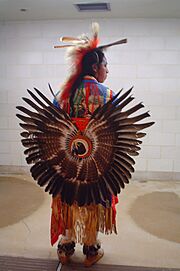
In 1992, some of the school's old buildings were listed on the National Register of Historic Places (NRHP). These included the hospital and four other early structures. They were part of the school's "old campus." These older buildings were taken down after the school moved in the late 1970s. The Chemawa Cemetery is the only part of the old campus that is still there.
Cemetery and Unmarked Graves
Many boarding schools, including Chemawa, had cemeteries for students who died while attending. The Chemawa cemetery was no longer used for student burials after 1940. In 1960, the cemetery was changed, and some grave markers were replaced using school records.
In 2016, it was reported that many unmarked graves of students were found at the Chemawa Indian School Cemetery. A student named Marsha Small used special radar to scan the ground. She found hundreds of possible unmarked graves. She compared this data to the 200 documented grave sites. Marsha Small wants to make people aware of these graves. She also wants to protect the cemetery from any damage from a nearby freeway project.
Notable Alumni
- Spade Cooley - a bandleader
- Frank LaPena - a Wintu American Indian painter, printmaker, professor, dancer, poet, and writer.
- Bob Greene - a Makah elder and veteran of World War II
- Pearl Warren - a Makah community organizer
See also
School Publications
- Kalama and Lear, The Indian Citizen, vol. 1, no. 1. Forest Grove, OR: Forest Grove Indian Industrial School, February 1884.
- H.L. Lovelace (manager), The Weekly Chemawa American. Chemawa, OR: Chemawa Indian School. Vol. 4 (1901).
Images for kids


